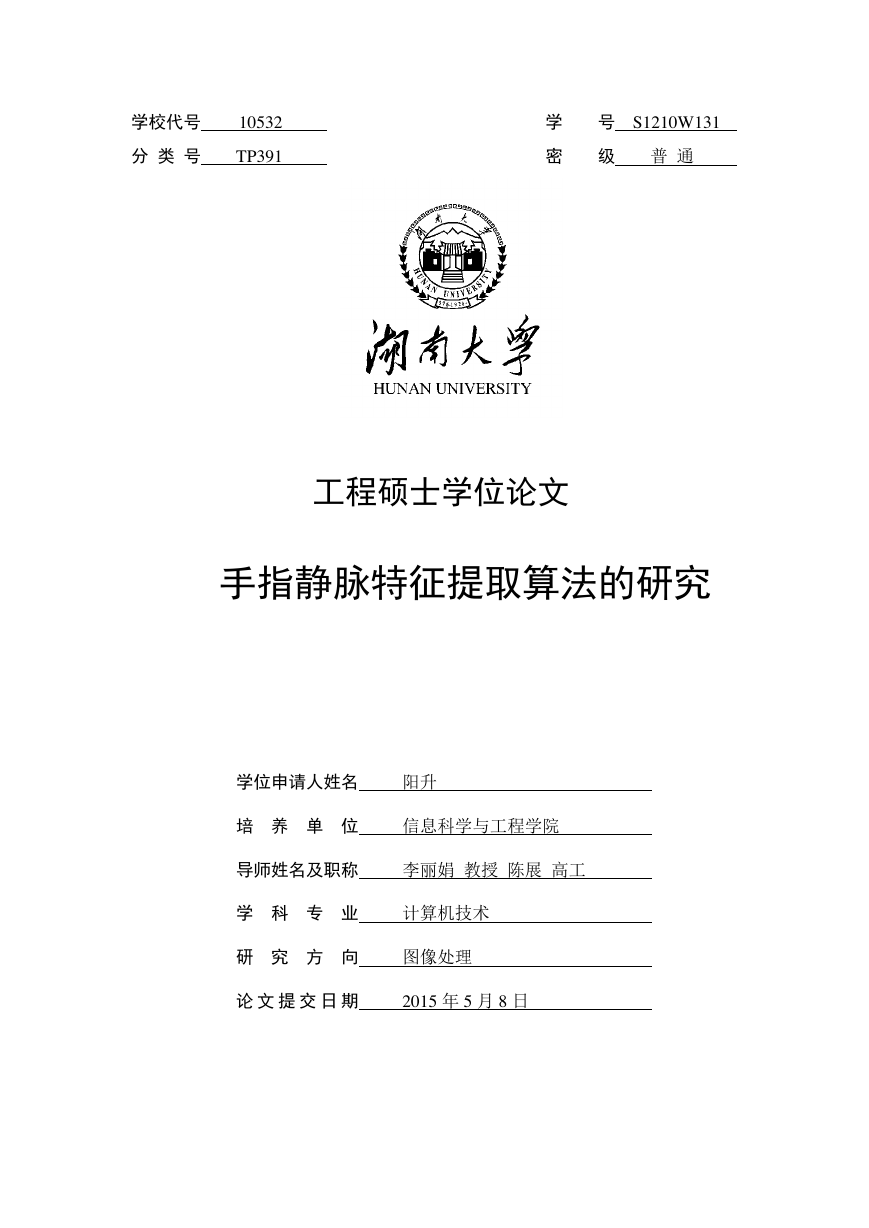学校代号 10532 学 号 S1210W131
分 类 号 TP391 密 级 普 通
工程硕士学位论文
手指静脉特征提取算法的研究
学位申请人姓名 阳升
培 养 单 位 信息科学与工程学院
导师姓名及职称 李丽娟 教授 陈展 高工
学 科 专 业 计算机技术
研 究 方 向 图像处理
论 文 提 交 日 期 2015 年 5 月 8 日
�
学校代号:10532
学
密
号:S1210W131
级:普通
湖南大学工程硕士学位论文
手指静脉特征提取算法的研究
学位申请人姓名: 阳升
导师姓名及职称:李丽娟 教授 陈展 高工
培 养 单 位: 信息科学与工程学院
专 业 名 称: 计算机技术
论 文 提 交 日 期: 2015 年 5 月 8 日
论 文 答 辩 日 期: 2015 年 5 月 23 日
答辩委员会主席: 杨高波 教授
�
Research on Finger Vein Feature Extraction Algorithm
by
YANG Sheng
B.E. (Jishou University) 2012
A thesis submitted in partial satisfaction of the
Requirements for the degree of
Master of Engineering
in
Communication Engineering
in the
Graduate School
of
Hunan University
Supervisor
Professor LI Lijuan
Senior Engineer CHEN Zhan
May,2015
�
湖 南 大 学
学位论文原创性声明
本人郑重声明:所呈交的论文是本人在导师的指导下独立进行研究所取得的
研究成果。除了文中特别加以标注引用的内容外,本论文不包含任何其他个人或
集体已经发表或撰写的成果作品。对本文的研究做出重要贡献的个人和集体,均
已在文中以明确方式标明。本人完全意识到本声明的法律后果由本人承担。
作者签名:
日期: 年 月 日
学位论文版权使用授权书
本学位论文作者完全了解学校有关保留、使用学位论文的规定,同意学校保
留并向国家有关部门或机构送交论文的复印件和电子版,允许论文被查阅和借阅。
本人授权湖南大学可以将本学位论文的全部或部分内容编入有关数据库进行检索,
可以采用影印、缩印或扫描等复制手段保存和汇编本学位论文。
本学位论文属于
1、保密□,在______年解密后适用本授权书。
2、不保密。
(请在以上相应方框内打“√”)
作者签名:
导师签名:
日期: 年 月 日
日期: 年 月 日
I
�
手指静脉特征提取算法的研究
摘 要
随着信息技术的高速发展,当今社会对信息安全的要求越来越高, 身份识别
是保证系统安全的重要手段。生物特征识别技术是一种利用人体固有的生理特征
或行为特征来进行身份识别的方法,比传统的身份识别技术更加安全而便捷。在
众多的生物特征识别技术中,指纹识别的技术发展相对成熟,但是随着应用的推
广,指纹识别显现出了许多的不足之处,比如指纹容易被复制和伪造等。手指静
脉识别是一种新型的非接触式的生物特征识别技术,它有效的克服了采集对象局
限于表面的缺点,具有广阔的应用前景。
在实际的应用中,由于受到采集设备的局限,采集到的手指静脉图片质量不
好,导致特征提取困难,从而会影响识别系统的准确性。 针对这些问题,本文对
手指静脉的特征提取算法进行了深入的研究,提出了高识别率的静脉特征提取算
法。本文的主要研究如下:
(1) 研究了基于小波变换的静脉图像处理。首先在 Mallat 算法理论的基础上
分析了小波变换在图像分解上的应用,然后研究了不同的小波变换对静脉图像处
理应当考虑的三个因素,即小波基函数的选择、小波分解层数的确定以及小波分
解组图的确定,最后通过实验验证了适合静脉图像的小波基函数、分解层数和分
解子图。
(2) 在小波变换的基础上,分析了小波变换系数权值的选择问题,提出了三
种改进算法,一是基于加权小波变换和成分分析 的特征融合算法,二是加权基于
小波变换和成分分析的决策融合算法,三是加权基于小波变换和核成分分析的特
征融合算法。通过理论和实验的分析,得出改进的算法与传统算法相比,大大提
高了系统的识别率。
关键词:特征提取;加权小波变换;主成分分析;核主成分分析;决策融合
II
�
工程硕士学位论文
Abstract
With the rapid development of information technology,today's society have
become
increasingly demanding on
information security,
identification
is an
important means to ensure system security. Biometric technology is safer and more
convenient than the traditional identification technology which is a use of human
natural physiological characteristics or behavioral charact eristics
to make
identification method. Among the biometric technologies, fingerprint recognition
technology is relatively mature, but with the promotion of the application ,
fingerprinting has shown a lot of shortcomings, such as a fingerprint is easily copied
and forged. Finger vein recognition is a new non-contact biometric technology, which
overcome the shortcomings of the acquisition object confined to the surface
effectively, and it has broad application prospects.
In practical applications, due to the limitations of the acquisition of equipment,
the acquisition of the finger vein images have poor quality so that the feature
extraction is difficult, which will affect the accuracy of the identification system. To
solve these problems, the paper conducted in-depth research on finger vein feature
extraction algorithm, and proposed the vein feature extraction algorithms for high
recognition rate. The main research is as follows:
(1) We researched on the vein image processing based on wavelet transform.
Firstly, we analyzed the application with wavelet transform image decomposition
based on Mallat algorithm theory. Then considered three factors that wavelet basis
functions selection, wavelet decomposition level determination and the determination
of the wavelet decomposition sub-maps with vein image processing on different
wavelet transform. Finally, experiments showed the suitable vein image wavelet
function, decomposition level and exploded sub-maps.
(2) This paper analyzed the choice of wavelet transform coeffic ients weights on
the basis of wavelet transform, we present three improved algorithm, the one is
feature fusion algorithm based on the weighted wavelet transform and component
analysis, the second is decision fusion algorithm based on the weighted wavelet
transform and component analysis, third is feature fusion algorithm based on the
weighted wavelet transform and kernel component analysis. The results showed that
III
�
手指静脉特征提取算法的研究
improved algorithm greatly improving the system of recognition rate compared with
traditional algorithm by analyzing the theoretical and experimental.
Key Words:Feature Extraction; Weighted Wavelet Transform; Principal Component
Analysis; Kernel Principal Component Analysis; Decision Fusion
IV
�
工程硕士学位论文
目 录
学位论文原创性声明学位论文版权使用授权书 ................................................ I
摘 要 ................................................................................................................ II
Abstract ........................................................................................................... III
插图索引 ......................................................................................................... VII
附表索引 ........................................................................................................ VIII
第 1 章 绪 论 .....................................................................................................1
1.1 论文的研究背景及意义 ........................................................................1
1.2 国内外研究现状 ...................................................................................3
1.2.1 静脉识别系统产品研究现状 .....................................................3
1.2.2 静脉识别算法研究现状 .............................................................5
1.3 本文主要研究内容 ...............................................................................6
1.4 本文的组织 ...........................................................................................7
第 2 章 图像预处理基础知识 ............................................................................8
2.1 手指静脉图像的获取 ...........................................................................8
2.2 感兴趣区域的提取 ................................................................................9
2.3 图像的归一化 ..................................................................................... 11
2.4 图像的滤波与去噪 ............................................................................. 13
2.5 本章小结 ............................................................................................. 14
第 3 章 基于小波变换的图像处理 .................................................................. 16
3.1 小波变换基础 ..................................................................................... 16
3.1.1 连续小波变换 .......................................................................... 16
3.1.2 离散小波变换 .......................................................................... 17
3.1.3 小波基函数 ............................................................................... 18
3.1.4 小波基函数的选择原则 ........................................................... 21
3.2 多分辨分析与 Mallat 算法 .................................................................. 23
3.2.1 多分辨分析 .............................................................................. 23
3.2.2 Mallat 算法 ................................................................................ 23
3.3 基于小波变换的静脉图像处理 ........................................................... 25
3.3.1 小波基函数的选择 ................................................................... 25
3.3.2 小波分解层数的确定 ............................................................... 26
3.3.3 小波分解子图的确定 ............................................................... 27
3.4 本章小结 .............................................................................................. 28
第 4 章 基于小波变换和子空间的特征提取算法 ........................................... 29
V
�
















 2023年江西萍乡中考道德与法治真题及答案.doc
2023年江西萍乡中考道德与法治真题及答案.doc 2012年重庆南川中考生物真题及答案.doc
2012年重庆南川中考生物真题及答案.doc 2013年江西师范大学地理学综合及文艺理论基础考研真题.doc
2013年江西师范大学地理学综合及文艺理论基础考研真题.doc 2020年四川甘孜小升初语文真题及答案I卷.doc
2020年四川甘孜小升初语文真题及答案I卷.doc 2020年注册岩土工程师专业基础考试真题及答案.doc
2020年注册岩土工程师专业基础考试真题及答案.doc 2023-2024学年福建省厦门市九年级上学期数学月考试题及答案.doc
2023-2024学年福建省厦门市九年级上学期数学月考试题及答案.doc 2021-2022学年辽宁省沈阳市大东区九年级上学期语文期末试题及答案.doc
2021-2022学年辽宁省沈阳市大东区九年级上学期语文期末试题及答案.doc 2022-2023学年北京东城区初三第一学期物理期末试卷及答案.doc
2022-2023学年北京东城区初三第一学期物理期末试卷及答案.doc 2018上半年江西教师资格初中地理学科知识与教学能力真题及答案.doc
2018上半年江西教师资格初中地理学科知识与教学能力真题及答案.doc 2012年河北国家公务员申论考试真题及答案-省级.doc
2012年河北国家公务员申论考试真题及答案-省级.doc 2020-2021学年江苏省扬州市江都区邵樊片九年级上学期数学第一次质量检测试题及答案.doc
2020-2021学年江苏省扬州市江都区邵樊片九年级上学期数学第一次质量检测试题及答案.doc 2022下半年黑龙江教师资格证中学综合素质真题及答案.doc
2022下半年黑龙江教师资格证中学综合素质真题及答案.doc